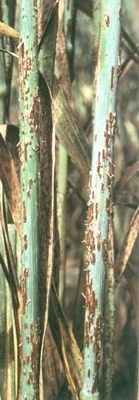Diseases
Puccinia graminis Pers. f.sp. secalis (Erikss.et Henn.) - Stem (Black) Rust of Rye.
Systematic position.
Class Basidiomycetes, subclass Teliosporomycetidae, order Uredinales, family Pucciniaceae, genus Puccinia.Biological group.
Biotroph.Morphology and biology.
Puccinia graminis is an heteroecious, macrocyclic, obligate parasitic fungus. Stages 0-I develop on Berberis spp., Mahonia spp., II-III on different genera of Poaceae. The species includes several formae speciales, and f.sp. secalis causes Stem Rust of Rye. The f.sp. secalis infects also species of Hordeum, Elytriga, Bromus, et al. Stem Rust of Rye is present as elongated pustules that erupt through the surface of host tissues. The pustules contain brick red urediniospores. They are formed on stem mainly, but may also occur on leaves and leaf sheaths. Urediniospores are ellipsoidal. As plants mature, the dark and shiny teliospores are formed. Teliospores are ellipsoidal, clavate, spindle-shaped. Telia winter; in spring the teliospores germinate and produce haploid basidiospores, which infect the alternative host, forming spermagonia. The spermacia copulate and a new diploid generation form aecia on the lower side of alternative host leaves. The aeciospores infect rye or other gramineous hosts, forming uredia and starting a new uredinial stage (after Ishkova et al., 2002).Distribution.
Occurs in different countries of Europe, Asia, America, and Australia with rye cultivation. In Russia it is found in the whole region, where the rye is cultivated.Ecology.
In temperate climate the disease appears usually on rye at the heading stage. Urediniospores germinate and penetrate leaves at 5 - 25.C (optimal temperature is 18-22.C) at the presence of condensed moisture (dew). Under the favorable conditions an uredogeneration develops for 7 days, so the development of several generations is possible for a season (Working., 1986). The urediniospores disseminate by wind for a short or long (hundreds km) distance. The winter rye gives the fungus an oppotunity to winter by urediniomycelium within plant tissue, if the rye is infected in autumn. Therfore, the absence of an alternative host does not influence the disease spreading in different geographical zones (Ishkova et al., 2002).Economic significance.
Stem Rust is one of the most destructive diseases. The infection increases water loss, decreases the amount of metabolites available for grain filling, causes stem fragility resulting in reduction of kernels number and weight. Yield losses amount to 10-20%, and 35% and more at epiphytotic condition (Solodukhina, 2000). Control measures include the use of resistant varieties, fungicides treatment (Nazarova et al., 1988; Working., 1986).Related reference:
Ishkova T.I., Berestetskaya L.I., Gasich E.L., Levitin M.M., Vlasov L.Iu. 2002. Diagnostics of the main fungus diseases of cereal crops, Saint Petersburg, 76 p. (in Russian).Nazarova L.N., Polityko P.M, Fochenkova T.V. 1988. Rye protection against rust in intensive cultivation technology, Moscow, 7 p. (in Russian).
Solodukhina O.V., Kobylyanskii V.D. 2000. Genetic determination of Stem Rust resistance on rye. Genetika, v.36, N 5, p. 678-681 (in Russian).
Transhel V.G. 1939. Review of rust fungi of the USSR, Moscow-Leningrad: Nauka, 426 p. (in Russian).
Working up of seasonal and short-term prognoses of Stem Rust of Rye. Moscow, 1986, 45 p. (in Russian).


